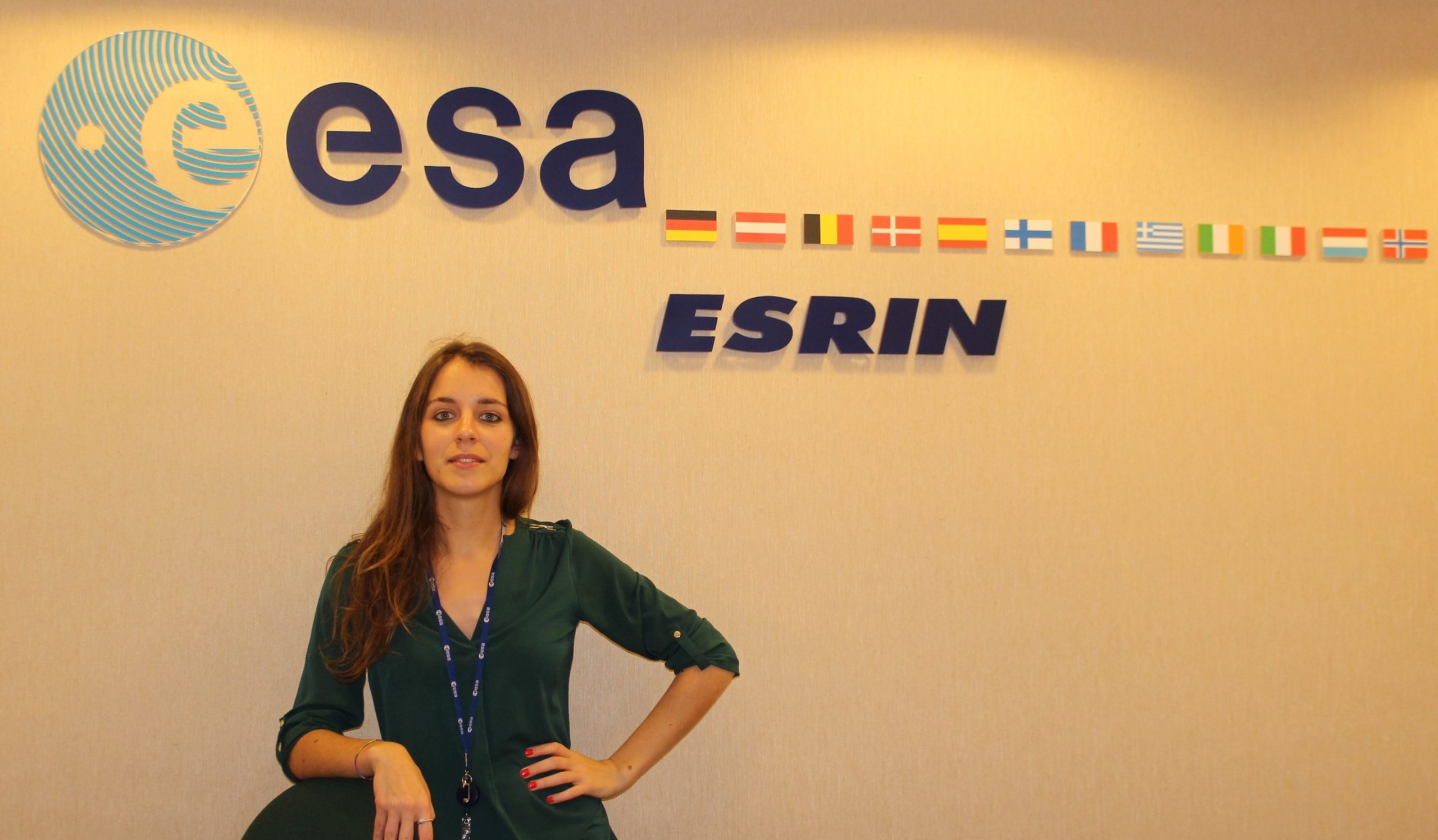From Environmental engineering to science communication — with an eye towards space
Sara Aparício arrived at ESA six years ago through the Young Graduate Trainee programme. Passionate about remote frozen regions, she studies the effects of climate change in such areas through Earth observation data and Artificial Intelligence. Recently, she used satellites to study the effects of Covid19 on the planet.
It’s fair to assume that “starry summer nights” can make anyone ecstatic. The stars that punctuate the dark sky open the door to a fascination with the unknown – and Sara Aparício remembers feeling exactly that way on a summer holiday night in the Alentejo. The universe had always piqued her curiosity, as well as the means humanity had found to “explain the inexplicable”. Apart from that, at home “we discussed physics, maths and space” and her parents, like her brothers, were “passionate about science”. Hence, now an Earth Observation data scientist at the European Space Agency (ESA), it is difficult to define a key moment that explains her interest in science. It happened and, at the same time, “it has always been there”.
Her desire to understand the world through exact sciences took precedence over anything else. If this hadn’t been the case, we might be talking about an artist today. “At secondary school, I even took the exams to apply for Fine Arts, but I think it would be a great shame not to make a career in science. So I preferred to follow that path and do art as a hobby”, explains the Lisboner from the Italian neighborhood Frascati, where the ESA Earth Observation Centre (ESRIN) is located.
Sara Aparício arrived at ESA in 2016 through the Young Graduate Trainee programme, an internship that offers young people the opportunity to gain experience in the development of space missions. Since then, she has been developing and studying the Earth observation component. Recently, she was part of the RACE project (Rapid Action Coronavirus Earth Observation), which aims to monitor how the pandemic influenced changes at the environmental level (of water and air quality) and in human activity (car traffic, air traffic, construction, agricultural production).
The scientist was an engineer first: “I studied Environmental Engineering at the Universidade Nova de Lisboa. This course has all the scientific building blocks: engineering, physics, chemistry, and biology. I had the opportunity to learn more about the planet through the geophysics component, but only then did I realise what I really liked”, she says. We’re getting there.
 Sara at the ESA Earth Observation Centre (ESRIN). ©DR
Sara at the ESA Earth Observation Centre (ESRIN). ©DR
In Frascati, the Lisboner has combined the knowledge acquired in Earth observation with Artificial Intelligence, “which helps to make more accurate predictions”: “A teacher of mine used to say something I’ve never forgotten: ‘Weather forecasting and meteorology is one thing, trying to predict the weather in ten years’ time is another. It’s black magic!'” And if it’s still not possible to make that forecast, “we see that our predictions always underestimate the worst scenarios,” she stresses. Because, in truth, “what [we predicted] would happen in a few decades is already happening”.
A frozen passion
Sara Aparício brings together Earth observation, Artificial Intelligence, and climate change in the doctoral thesis she has been working on since 2020. Sara applies these themes to the study of what is a “great passion”: the cryosphere (regions of the Earth’s surface permanently covered by ice and snow or parts of the ground that contain ice).
It was on a trip to Greenland, under the auspices of a scientific research trip, that Sara Aparício fell in love “at first sight” with the Arctic. “It marked me in an extreme way.” So much so that, when she returned to Portugal, she immediately tried to find out if there were any polar scientists here. She found them in APECS (Association of Polar Early Career Scientists) and, since then, she has never lost “the connection to the Arctic world”. “And whenever I get an opportunity, I go there!” she admits.
In addition to visits to frozen landscapes, the work developed at APECS also gave Sara Aparício “a desirable skill”: communicating science with various audiences, “from four-year-olds to 80-year-olds”. “It was extremely beneficial because I didn’t have that experience and from then on I was unafraid to do it. So much so that at ESA I had the opportunity to give my face, in communication, for Sentinel-2b and 3b.”
Based on her experience, the scientist argues that it is not enough to collect data – you need to know how to disseminate it in the best way. Because, apart from helping “political decisions” that aim to conserve the environment, they also help to combat misinformation: “It is very important to communicate what we learn from satellites. We need to clearly inform the general population, to avoid negative discourses, not only related to the pandemic, but also to climate change.”
In addition, she notes, Earth observation services, such as the European Copernicus programme, help humanity to see what is really going on “around it”. With the data collected by satellites, it is possible to compare different samples over time, which allows us to draw patterns that “show how things have changed over the past decades”, especially at a time of climate emergency. And, more than that, “we get an overview of the complexity of our planet” – from where we spot those fascinating starry summer nights.
